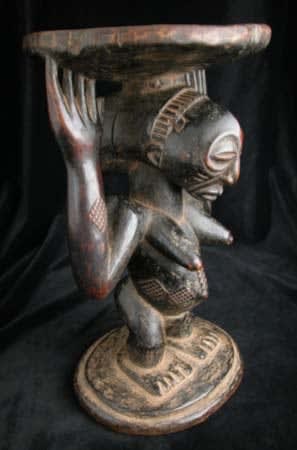Hemba Wooden Caryatid Stool, 20th Century CE
Wood
12.75
PF.6251 (LSO)
Further images
This powerful caryatid stool was made by the Hemba of what was once Zaire. It represents a woman standing on the base and supporting the seat on her head and...
This powerful caryatid stool was made by the Hemba of what was once Zaire. It represents a woman standing on the base and supporting the seat on her head and upstretched hands. The rendering is fairly traditional – the limbs are short and powerful, with a robust body liberally decorated with scarifications. The face is austere and well-defined, with a solemn and dignified expression. The figure is evidently female, as is usual for these pieces. Caryatid stools are traditionally markers of status, particularly associated with chiefs; the symbolism of such pieces is very evident, being literally supported by one’s followers. In some cases, the stools were not even sat upon and were just exhibited as evidence of the owners’ right to rule. They are inherited from father to son, and are treated with the reverence given to thrones in the west.
The Hemba are an agriculturally-based group living on the banks of the Lualaba River, in what was once Zaire. They are arranged into large groups which approximate to clans, each of which has a common ancestor, and is headed by an elder known as the Fuma Mwalo. He is responsible for justice, receives tribute from his subordinates; his power is counterbalanced by secret societies called Bukazanzi (for men) and Bukibilo (for women).
The Hemba were long believed to be contiguous with the Luba. However, their artistic production can be differentiated in terms of the delicacy of the carving. They are known for their caryatid stools, headrests and instruments. Their masks are highly distinctive although their social role is currently unclear. Hemba features tend to be sharper than their Luba comparatives, with more detailing (such as hair and beards) and a subtle geometric quality. Hemba figures – singiti – usually represent male ancestors: naked figures standing on circular bases, with elongated torsos, hands resting on protuberant stomachs (representing wealth or prosperity), beards, and coiffure drawn back and formed into the shape of a cross.
Warrior figures confer power, and are usually kept by the Fuma Mwalo; they usually have an encrusted patina as animals (usually chickens) are sacrificed to them during ceremonies to recall the glories of their lives. The Fuma Mwalo also keeps small Janus figures known as kabejas, which are made magical by the addition of substances to small depressions in their heads; their role is to protect the village, and also receive libations to ensure they do so adequately. It is perhaps the caryatid stools that have received the greatest attention, however. The greatest carver of such objects - and one of the very few indigenous artists known specifically to western art historians – was the “Master of Buli”, a Hemba artist active in the very early 20th century.
This is a well-rendered and elegant piece of African secular art, and would be a striking addition to any collection or sophisticated domestic setting.
The Hemba are an agriculturally-based group living on the banks of the Lualaba River, in what was once Zaire. They are arranged into large groups which approximate to clans, each of which has a common ancestor, and is headed by an elder known as the Fuma Mwalo. He is responsible for justice, receives tribute from his subordinates; his power is counterbalanced by secret societies called Bukazanzi (for men) and Bukibilo (for women).
The Hemba were long believed to be contiguous with the Luba. However, their artistic production can be differentiated in terms of the delicacy of the carving. They are known for their caryatid stools, headrests and instruments. Their masks are highly distinctive although their social role is currently unclear. Hemba features tend to be sharper than their Luba comparatives, with more detailing (such as hair and beards) and a subtle geometric quality. Hemba figures – singiti – usually represent male ancestors: naked figures standing on circular bases, with elongated torsos, hands resting on protuberant stomachs (representing wealth or prosperity), beards, and coiffure drawn back and formed into the shape of a cross.
Warrior figures confer power, and are usually kept by the Fuma Mwalo; they usually have an encrusted patina as animals (usually chickens) are sacrificed to them during ceremonies to recall the glories of their lives. The Fuma Mwalo also keeps small Janus figures known as kabejas, which are made magical by the addition of substances to small depressions in their heads; their role is to protect the village, and also receive libations to ensure they do so adequately. It is perhaps the caryatid stools that have received the greatest attention, however. The greatest carver of such objects - and one of the very few indigenous artists known specifically to western art historians – was the “Master of Buli”, a Hemba artist active in the very early 20th century.
This is a well-rendered and elegant piece of African secular art, and would be a striking addition to any collection or sophisticated domestic setting.









